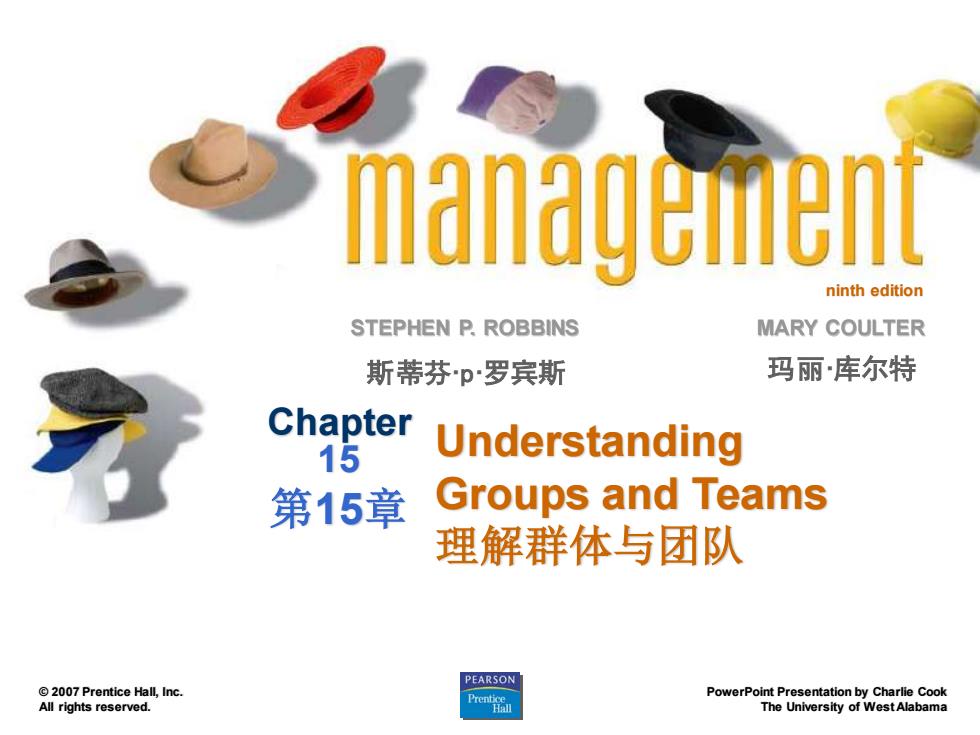
management ninth edition STEPHEN P.ROBBINS MARY COULTER 斯蒂芬p罗宾斯 玛丽库尔特 Chapter 15 Understanding 第15章 Groups and Teams 理解群体与团队 PEARSON 2007 Prentice Hall,Inc. PowerPoint Presentation by Charlie Cook All rights reserved. The University of WestAlabama
ninth edition STEPHEN P. ROBBINS PowerPoint Presentation by Charlie Cook The University of West Alabama MARY COULTER © 2007 Prentice Hall, Inc. All rights reserved. Understanding Groups and Teams 理解群体与团队 Chapter 15 第15章 斯蒂芬·p·罗宾斯 玛丽·库尔特
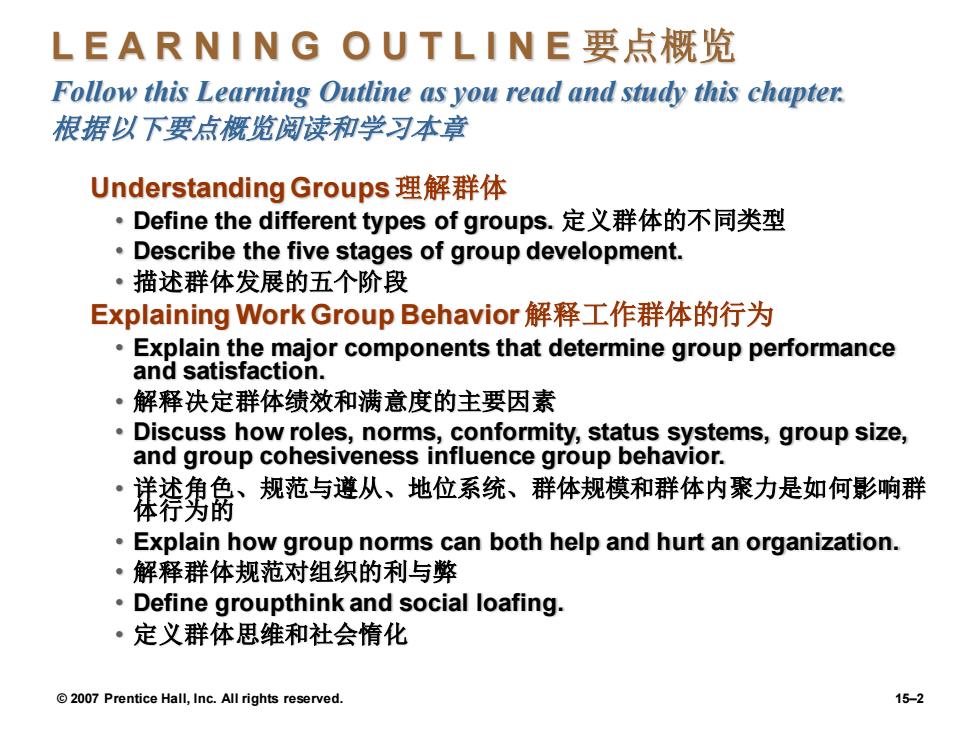
LEARNING OUTLINE要点概览 Follow this Learning Outline as you read and study this chapter. 根据以下要点概览阅读和学习本章 Understanding Groups理解群体 ·Define the different types of groups.定义群体的不同类型 Describe the five stages of group development. ·描述群体发展的五个阶段 Explaining Work Group Behavior解释工作群体的行为 Explain the major components that determine group performance and satisfaction. ·解释决定群体绩效和满意度的主要因素 Discuss how roles,norms,conformity,status systems,group size, and group cohesiveness influence group behavior. 。1 详述角色、规范与遵从、地位系统、群体规模和群体内聚力是如何影响群 体行为的 Explain how group norms can both help and hurt an organization. ·解释群体规范对组织的利与弊 Define groupthink and social loafing. ·定义群体思维和社会惰化 2007 Prentice Hall,Inc.All rights reserved. 15-2
© 2007 Prentice Hall, Inc. All rights reserved. 15–2 L E A R N I N G O U T L I N E 要点概览 Follow this Learning Outline as you read and study this chapter. 根据以下要点概览阅读和学习本章 Understanding Groups 理解群体 • Define the different types of groups. 定义群体的不同类型 • Describe the five stages of group development. • 描述群体发展的五个阶段 Explaining Work Group Behavior 解释工作群体的行为 • Explain the major components that determine group performance and satisfaction. • 解释决定群体绩效和满意度的主要因素 • Discuss how roles, norms, conformity, status systems, group size, and group cohesiveness influence group behavior. • 详述角色、规范与遵从、地位系统、群体规模和群体内聚力是如何影响群 体行为的 • Explain how group norms can both help and hurt an organization. • 解释群体规范对组织的利与弊 • Define groupthink and social loafing. • 定义群体思维和社会惰化

LEARNING OUTLINE(cont'd) 要点概览(续) Follow this Learning Outline as you read and study this chapter. 根据以下要点概览阅读和学习本章 Explaining Work Group Behavior(cont'd) 解释工作群体的行为(续) Describe the relationships between group cohesiveness and productivity.描述群体内聚力和生产率的关系 Discuss how conflict management influences group behavior. ·详述冲突管理如何影响群体行为 Tell the advantages and disadvantages of group decision making. 明群体决策的优点与缺点 Creating Effective Teams创造高效团队 ·Compare groups and teams.比较群体和团队 Explain why teams have become so popular in organizations. ·解释为什么团队在组织中如此普遍 Describe the four most common types of teams. ·描述四种最普通的团队 2007 Prentice Hall,Inc.All rights reserved. 15-3
© 2007 Prentice Hall, Inc. All rights reserved. 15–3 L E A R N I N G O U T L I N E (cont’d) 要点概览(续) Follow this Learning Outline as you read and study this chapter. 根据以下要点概览阅读和学习本章 Explaining Work Group Behavior (cont’d) 解释工作群体的行为(续) • Describe the relationships between group cohesiveness and productivity. 描述群体内聚力和生产率的关系 • Discuss how conflict management influences group behavior. • 详述冲突管理如何影响群体行为 • Tell the advantages and disadvantages of group decision making. 说 明群体决策的优点与缺点 Creating Effective Teams 创造高效团队 • Compare groups and teams. 比较群体和团队 • Explain why teams have become so popular in organizations. • 解释为什么团队在组织中如此普遍 • Describe the four most common types of teams. • 描述四种最普通的团队
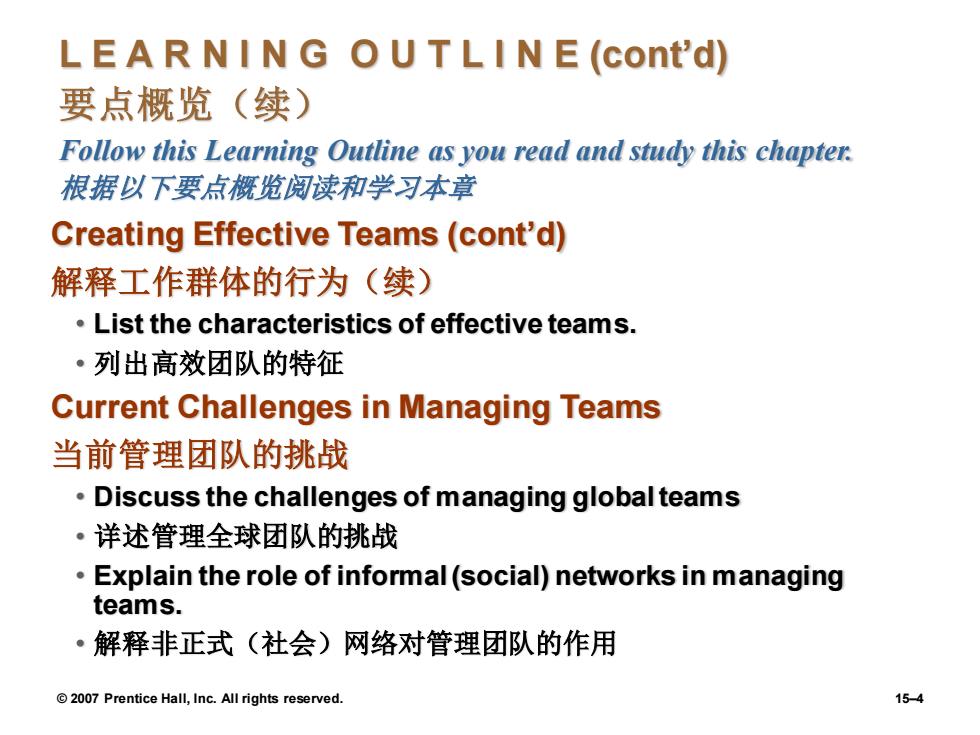
LEARNING OUTLINE(cont'd) 要点概览(续) Follow this Learning Outline as you read and study this chapter. 根据以下要点概览阅读和学习本章 Creating Effective Teams(cont'd) 解释工作群体的行为(续) List the characteristics of effective teams. ·列出高效团队的特征 Current Challenges in Managing Teams 当前管理团队的挑战 Discuss the challenges of managing global teams ·详述管理全球团队的挑战 Explain the role of informal(social)networks in managing teams. ·解释非正式(社会)网络对管理团队的作用 2007 Prentice Hall,Inc.All rights reserved. 15-4
© 2007 Prentice Hall, Inc. All rights reserved. 15–4 L E A R N I N G O U T L I N E (cont’d) 要点概览(续) Follow this Learning Outline as you read and study this chapter. 根据以下要点概览阅读和学习本章 Creating Effective Teams (cont’d) 解释工作群体的行为(续) • List the characteristics of effective teams. • 列出高效团队的特征 Current Challenges in Managing Teams 当前管理团队的挑战 • Discuss the challenges of managing global teams • 详述管理全球团队的挑战 • Explain the role of informal (social) networks in managing teams. • 解释非正式(社会)网络对管理团队的作用

Understanding Groups理解群体 ·Group群体 Two or more interacting and interdependent individuals who come together to achieve specific goals. >两个或两个以上相互作用、相互依赖的个体,为实现特定的目标而组合在一起的 集合体 >Formal groups正式群体 Work groups defined by the organization's structure that have designated work assignments and tasks. 。由组织建立的工作群体,有着明确的分工和具体的工作任务 -Appropriate behaviors are defined by and directed toward organizational goals. 一恰当的行为取决于组织的目的,直接指向组织目标 >Informal groups非正式群体 Groups that are independently formed to meet the social needs of their members. ·自然独立形成的群体,满足组织成员的社会需求 2007 Prentice Hall,Inc.All rights reserved. 15-5
© 2007 Prentice Hall, Inc. All rights reserved. 15–5 Understanding Groups 理解群体 • Group 群体 ➢ Two or more interacting and interdependent individuals who come together to achieve specific goals. ➢ 两个或两个以上相互作用、相互依赖的个体,为实现特定的 目标而组合在一起的 集合体 ➢ Formal groups 正式群体 ❖ Work groups defined by the organization’s structure that have designated work assignments and tasks. ❖ 由组织建立的工作群体,有着明确的分工和具体的工作任务 – Appropriate behaviors are defined by and directed toward organizational goals. – 恰当的行为取决于组织的目的,直接指向组织目标 ➢ Informal groups 非正式群体 ❖ Groups that are independently formed to meet the social needs of their members. ❖ 自然独立形成的群体,满足组织成员的社会需求
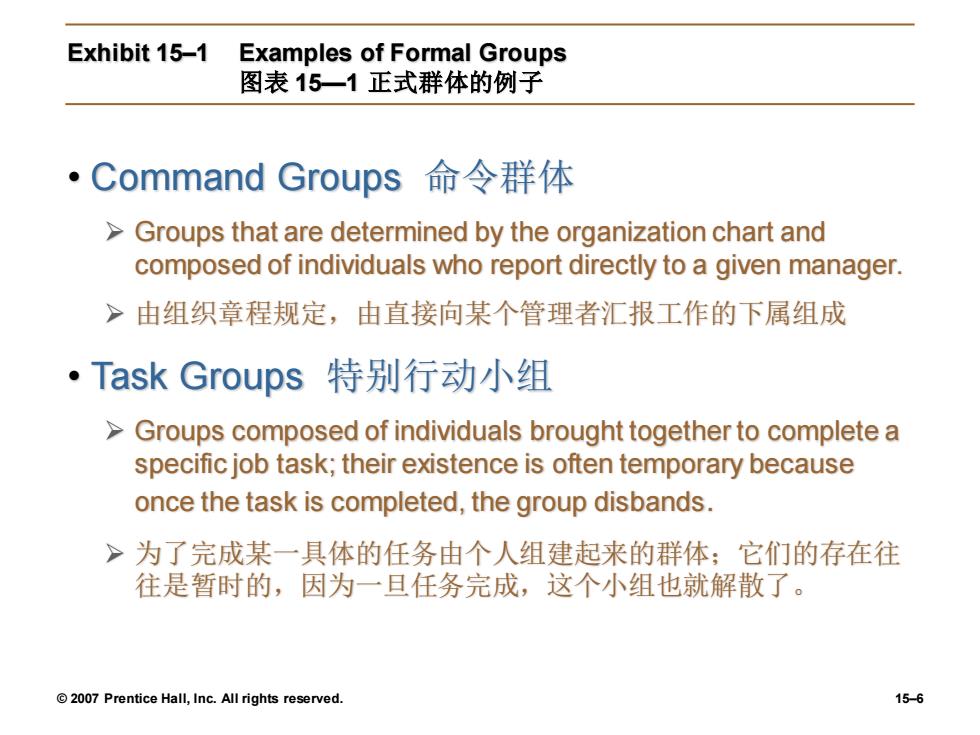
Exhibit 15-1 Examples of Formal Groups 图表15一1正式群体的例子 ·Command Groups命令群体 >Groups that are determined by the organization chart and composed of individuals who report directly to a given manager. >由组织章程规定,由直接向某个管理者汇报工作的下属组成 ·Task Groups特别行动小组 >Groups composed of individuals brought together to complete a specific job task;their existence is often temporary because once the task is completed,the group disbands. >为了完成某一具体的任务由个人组建起来的群体;它们的存在往 往是暂时的,因为一旦任务完成,这个小组也就解散了。 2007 Prentice Hall,Inc.All rights reserved. 15-6
© 2007 Prentice Hall, Inc. All rights reserved. 15–6 Exhibit 15–1 Examples of Formal Groups 图表 15—1 正式群体的例子 • Command Groups 命令群体 ➢ Groups that are determined by the organization chart and composed of individuals who report directly to a given manager. ➢ 由组织章程规定,由直接向某个管理者汇报工作的下属组成 • Task Groups 特别行动小组 ➢ Groups composed of individuals brought together to complete a specific job task; their existence is often temporary because once the task is completed, the group disbands. ➢ 为了完成某一具体的任务由个人组建起来的群体;它们的存在往 往是暂时的,因为一旦任务完成,这个小组也就解散了
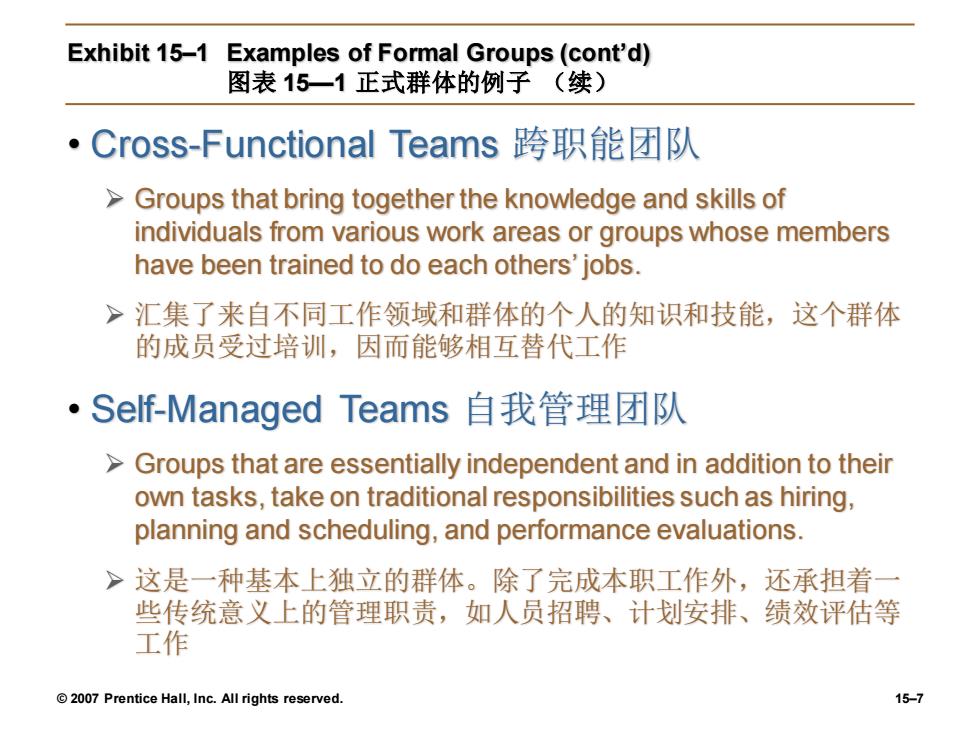
Exhibit 15-1 Examples of Formal Groups(cont'd) 图表15一1正式群体的例子(续) ·Cross-Functional Teams跨职能团队 >Groups that bring together the knowledge and skills of individuals from various work areas or groups whose members have been trained to do each others'jobs >汇集了来自不同工作领域和群体的个人的知识和技能,这个群体 的成员受过培训,因而能够相互替代工作 ·Self-Managed Teams自我管理团队 >Groups that are essentially independent and in addition to their own tasks,take on traditional responsibilities such as hiring, planning and scheduling,and performance evaluations >这是一种基本上独立的群体。除了完成本职工作外,还承担着一 些传统意义上的管理职责,如人员招聘、计划安排、绩效评估等 工作 2007 Prentice Hall,Inc.All rights reserved. 15-7
© 2007 Prentice Hall, Inc. All rights reserved. 15–7 Exhibit 15–1 Examples of Formal Groups (cont’d) 图表 15—1 正式群体的例子 (续) • Cross-Functional Teams 跨职能团队 ➢ Groups that bring together the knowledge and skills of individuals from various work areas or groups whose members have been trained to do each others’ jobs. ➢ 汇集了来自不同工作领域和群体的个人的知识和技能,这个群体 的成员受过培训,因而能够相互替代工作 • Self-Managed Teams 自我管理团队 ➢ Groups that are essentially independent and in addition to their own tasks, take on traditional responsibilities such as hiring, planning and scheduling, and performance evaluations. ➢ 这是一种基本上独立的群体。除了完成本职工作外,还承担着一 些传统意义上的管理职责,如人员招聘、计划安排、绩效评估等 工作
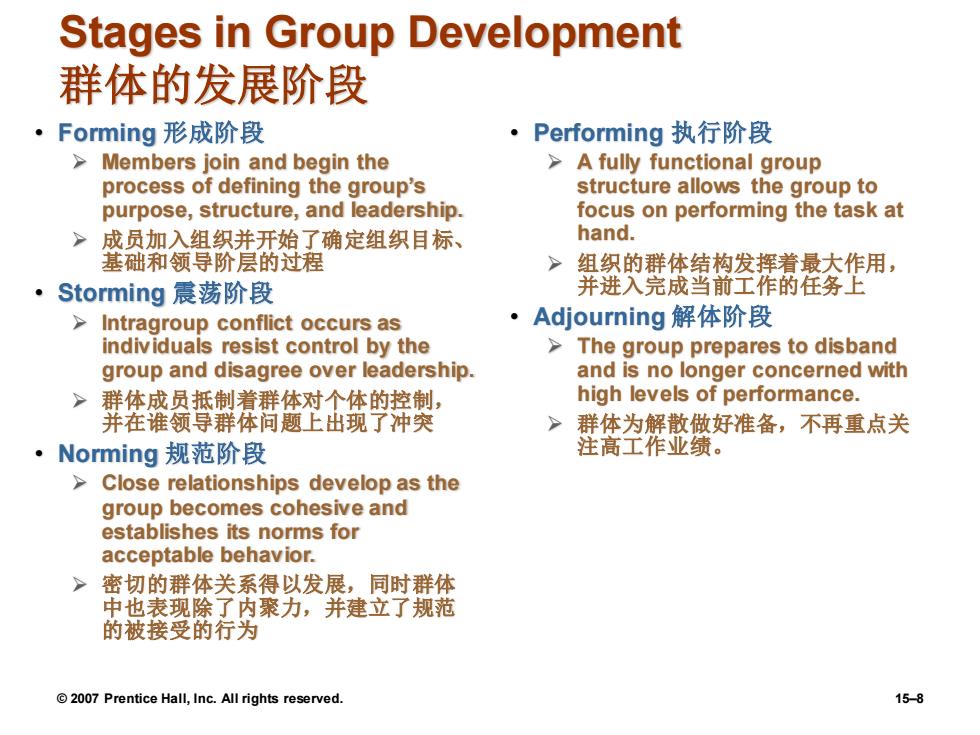
Stages in Group Development 群体的发展阶段 ·Forming形成阶段 ·Performing执行阶段 > Members join and begin the > A fully functional group process of defining the group's structure allows the group to purpose,structure,and leadership. focus on performing the task at 成员加入组织并开始了确定组织目标、 hand. 基础和领导阶层的过程 > 组织的群体结构发挥着最大作用, ·Storming震荡阶段 并进入完成当前工作的任务上 >Intragroup conflict occurs as ·Adjourning解体阶段 individuals resist control by the >The group prepares to disband group and disagree over leadership. and is no longer concerned with 》群体成员抵制着群体对个体的控制, high levels of performance. 并在谁领导群体问题上出现了冲突 > 群体为解散做好准备,不再重点关 ·Norming规范阶段 注高工作业绩。 >Close relationships develop as the group becomes cohesive and establishes its norms for acceptable behavior. >密切的群体关系得以发展,同时群体 中也表现除了内聚力,并建立了规范 的被接受的行为 2007 Prentice Hall,Inc.All rights reserved. 15-8
© 2007 Prentice Hall, Inc. All rights reserved. 15–8 Stages in Group Development 群体的发展阶段 • Forming 形成阶段 ➢ Members join and begin the process of defining the group’s purpose, structure, and leadership. ➢ 成员加入组织并开始了确定组织目标、 基础和领导阶层的过程 • Storming 震荡阶段 ➢ Intragroup conflict occurs as individuals resist control by the group and disagree over leadership. ➢ 群体成员抵制着群体对个体的控制, 并在谁领导群体问题上出现了冲突 • Norming 规范阶段 ➢ Close relationships develop as the group becomes cohesive and establishes its norms for acceptable behavior. ➢ 密切的群体关系得以发展,同时群体 中也表现除了内聚力,并建立了规范 的被接受的行为 • Performing 执行阶段 ➢ A fully functional group structure allows the group to focus on performing the task at hand. ➢ 组织的群体结构发挥着最大作用, 并进入完成当前工作的任务上 • Adjourning 解体阶段 ➢ The group prepares to disband and is no longer concerned with high levels of performance. ➢ 群体为解散做好准备,不再重点关 注高工作业绩
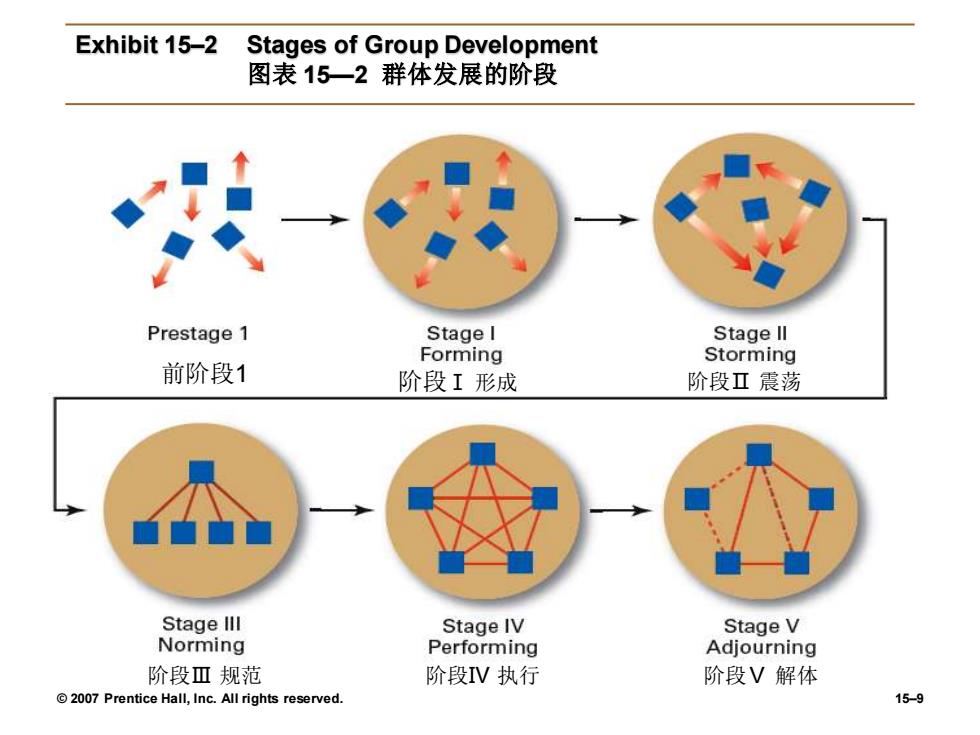
Exhibit 15-2 Stages of Group Development 图表15一2群体发展的阶段 Prestage 1 Stage I Stage ll Forming Storming 前阶段1 阶段I形成 阶段Ⅱ震荡 Stage Ill Stage IV Stage V Norming Performing Adjourning 阶段Ⅲ规范 阶段IV执行 阶段V解体 2007 Prentice Hall,Inc.All rights reserved. 15-9
© 2007 Prentice Hall, Inc. All rights reserved. 15–9 Exhibit 15–2 Stages of Group Development 图表 15—2 群体发展的阶段 前阶段1 阶段Ⅰ 形成 阶段Ⅱ 震荡 阶段Ⅲ 规范 阶段Ⅳ 执行 阶段Ⅴ 解体

Exhibit 15-3 Group Behavior Model 图表15一3群体行为模型 群体 群体 任务 成员 作用于 资源 群体 群体 工作 运行 的外部 绩效与 过程 环境 满意度 群体 结构 2007 Prentice Hall,Inc.All rights reserved. 15-10
© 2007 Prentice Hall, Inc. All rights reserved. 15–10 Exhibit 15–3 Group Behavior Model 图表 15—3 群体行为模型 作用于 群体 的外部 环境 群体 成员 资源 群体 结构 群体 运行 过程 群体 任务 工作 绩效与 满意度